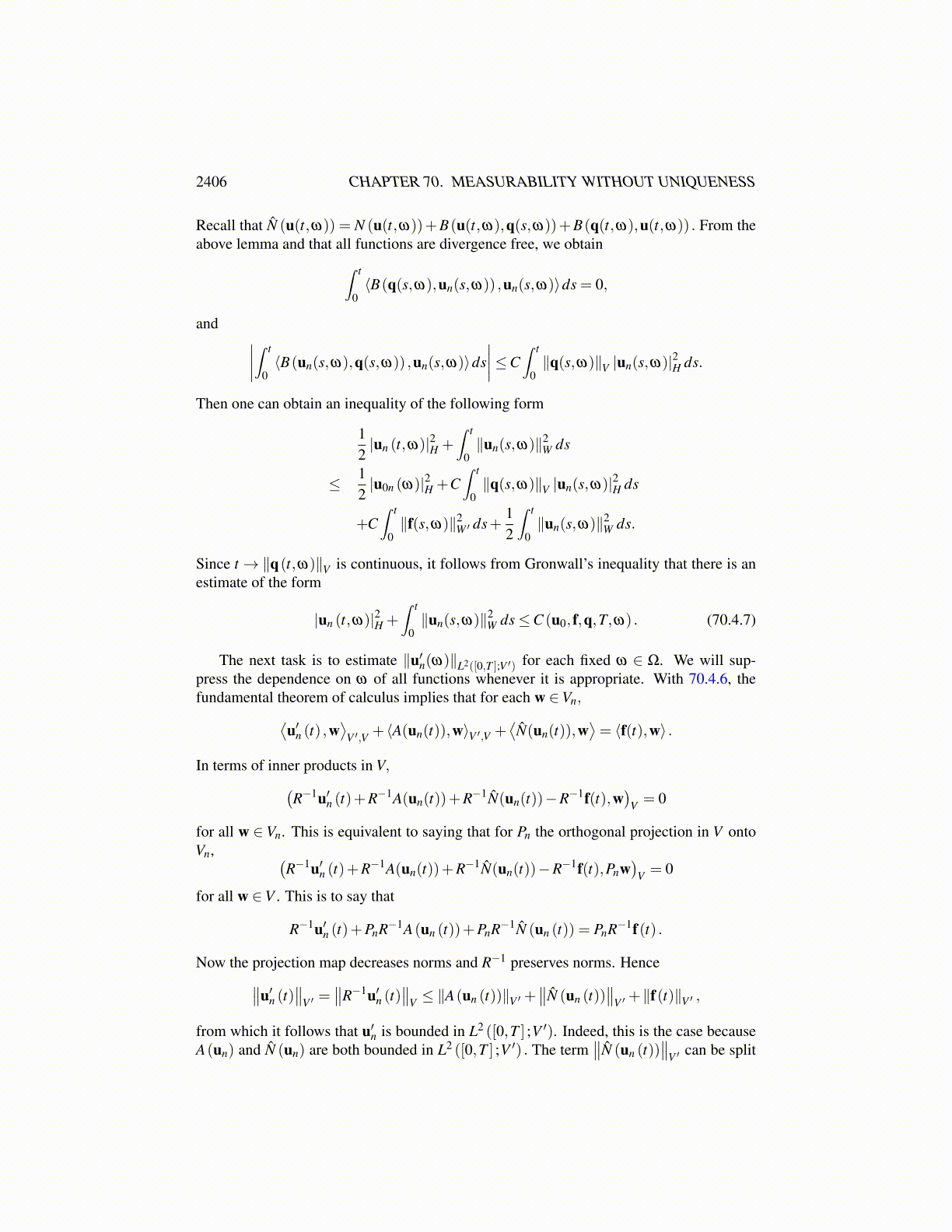
2406 CHAPTER 70. MEASURABILITY WITHOUT UNIQUENESS
In order to apply the earlier result, let w(t,ω)=u(t,ω)−q(t,ω) and write the equationin terms of w,
w(t,ω)−u0 (ω)+∫ t
0A(w(s,ω)+q(s,ω))ds+
∫ t
0N (w(s,ω)+q(s,ω))ds
=∫ t
0f(s,ω)ds.
It turns out that it is convenient to define
⟨B(u,v) ,w⟩ ≡ −∫
Uuiv jw j,idx,
and write the equation in the following form:
w(t,ω)−u0 (ω)+∫ t
0A(w(s,ω))ds+
∫ t
0N̂ (w(s,ω))ds =
∫ t
0f̂(s,ω)ds,
where
N̂ (w(t,ω))≡ N (w(t,ω))+B(w(t,ω),q(t,ω))+B(q(t,ω),w(t,ω)) ,
f̂(t,ω)≡ f(t,ω)−A(q(t,ω))−N (q(t,ω)) .
This is an equation in V ′. Moreover, we have the following:
Lemma 70.4.3 For fixed ω ∈Ω, f̂ ∈ L2 ([0,T ] ;W ′) , and
(t,w)→ B(w,q(t,ω)) , (t,w)→ B(q(t,ω),w)
are continuous functions having values in W ′. For fixed w ∈W,
(t,ω)→ B(w,q(t,ω)) , (t,ω)→ B(q(t,ω) ,w)
are product measurable. In addition to this, if z ∈W,
|⟨B(w,q(t,ω)) ,z⟩| ≤ C∥q(t,ω)∥V ∥w∥H ∥z∥H ,
|⟨B(q(t,ω),w) ,z⟩| ≤ C∥q(t,ω)∥V ∥w∥H ∥z∥H .
Proof: The first claim is straightforward to prove from the definition of A and N. Con-sider the next claim about continuity. Let z ∈W be given. Then from the fact that all thefunctions are divergence free,
|⟨B(w,q(t))−B(w̄,q(s)) ,z⟩|
≡∣∣∣∣∫U
(wiq j (t)− w̄iq j (s))z j,idx∣∣∣∣= ∣∣∣∣∫U
(wiq j,i (t)− w̄iq j,i (s))z jdx∣∣∣∣
≤∣∣∣∣∫U
(wiq j,i (t)− w̄iq j,i (t))z jdx∣∣∣∣+ ∣∣∣∣∫U
(w̄iq j,i (t)− w̄iq j,i (s))z jdx∣∣∣∣
≤ C(∥q(t)∥V
∫U|w− w̄| |z|dx+∥q(t)−q(s)∥V
∫U|w̄| |z|dx
)≤ C (∥q(t)∥V |w− w̄|H +∥q(t)−q(s)∥V |w̄|H) |z|H ,